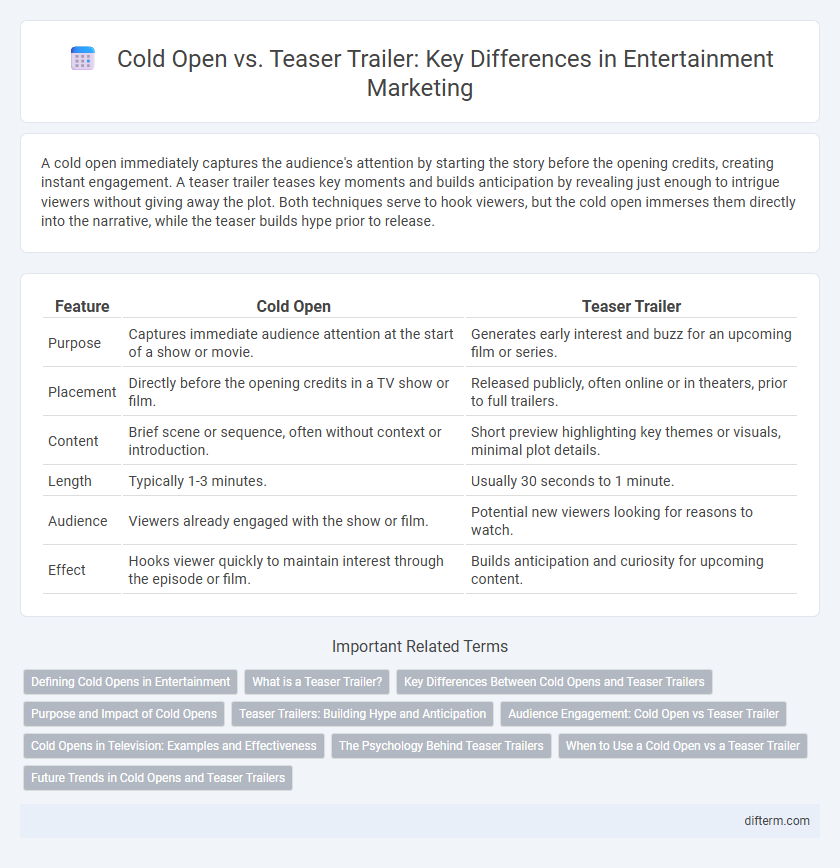A cold open immediately captures the audience's attention by starting the story before the opening credits, creating instant engagement. A teaser trailer teases key moments and builds anticipation by revealing just enough to intrigue viewers without giving away the plot. Both techniques serve to hook viewers, but the cold open immerses them directly into the narrative, while the teaser builds hype prior to release.
Table of Comparison
| Feature | Cold Open | Teaser Trailer |
|---|---|---|
| Purpose | Captures immediate audience attention at the start of a show or movie. | Generates early interest and buzz for an upcoming film or series. |
| Placement | Directly before the opening credits in a TV show or film. | Released publicly, often online or in theaters, prior to full trailers. |
| Content | Brief scene or sequence, often without context or introduction. | Short preview highlighting key themes or visuals, minimal plot details. |
| Length | Typically 1-3 minutes. | Usually 30 seconds to 1 minute. |
| Audience | Viewers already engaged with the show or film. | Potential new viewers looking for reasons to watch. |
| Effect | Hooks viewer quickly to maintain interest through the episode or film. | Builds anticipation and curiosity for upcoming content. |
Defining Cold Opens in Entertainment
Cold opens in entertainment are narrative techniques where a show or film begins directly with a scene before the title sequence or opening credits, designed to immediately engage viewers by presenting a dramatic or comedic moment. Unlike teaser trailers that serve as promotional previews released before a movie or episode premiere, cold opens function as integral parts of the storytelling structure, setting the tone or introducing key plot points right from the start. This technique is commonly used in television dramas, sitcoms, and streaming series to hook the audience and encourage continued viewing.
What is a Teaser Trailer?
A teaser trailer is a short promotional video designed to generate excitement and anticipation for an upcoming film or television show by revealing minimal plot details and key visuals. It often focuses on mood, tone, and atmosphere rather than story, engaging audiences with brief, intriguing snippets. Unlike a cold open, which is part of the actual content, a teaser trailer serves purely as a marketing tool to build hype before the full release.
Key Differences Between Cold Opens and Teaser Trailers
Cold opens immediately plunge viewers into a crucial scene or plot point before the opening credits, designed to hook the audience with suspense or action. Teaser trailers serve as brief promotional videos that hint at the theme and tone of an upcoming project without revealing significant plot details, aiming to build anticipation. The key difference lies in their function: cold opens engage viewers in the narrative within the content itself, while teaser trailers market the content externally.
Purpose and Impact of Cold Opens
Cold opens serve to immediately engage viewers by dropping them into a high-stakes or intriguing moment before the title sequence, creating instant suspense and curiosity that drives continued watching. Unlike teaser trailers, which are promotional tools designed to generate buzz and anticipation before a release, cold opens function as narrative devices that set the tone and hook the audience within the content itself. Their impact lies in enhancing viewer retention and emotional investment by delivering compelling storytelling right from the start.
Teaser Trailers: Building Hype and Anticipation
Teaser trailers serve as strategic marketing tools in entertainment, designed to generate hype and anticipation by offering a brief, intriguing glimpse of an upcoming film or show without revealing major plot points. Unlike cold opens that jump directly into the story to captivate viewers, teaser trailers build excitement through carefully crafted visuals and minimal dialogue, targeting audience curiosity. Effective teaser trailers boost pre-release engagement on social media platforms and contribute significantly to opening weekend box office performance.
Audience Engagement: Cold Open vs Teaser Trailer
Cold opens instantly capture audience attention by plunging viewers directly into a compelling scene, heightening curiosity and boosting immediate engagement. Teaser trailers build anticipation over time by offering brief glimpses that spark interest without revealing key plot points. Strategic use of cold opens and teaser trailers maximizes audience investment by balancing suspense with storytelling momentum.
Cold Opens in Television: Examples and Effectiveness
Cold opens in television hook viewers immediately by starting scenes before the opening credits, often featuring a dramatic or humorous moment that sets the tone. Effective examples include "Breaking Bad," where cold opens create suspense and intrigue, and "The Office," which uses them to deliver quick comedic punchlines. These openings increase viewer engagement and retention by captivating audiences before the narrative formally begins.
The Psychology Behind Teaser Trailers
Teaser trailers leverage psychological triggers like curiosity and anticipation by revealing minimal yet intriguing scenes to engage the audience's imagination. Cold opens immediately immerse viewers into the narrative, creating a sense of urgency and emotional investment. Teaser trailers strategically manipulate attention and expectation, maximizing impact through suspense and selective information disclosure.
When to Use a Cold Open vs a Teaser Trailer
Cold opens are best used within television episodes or films to immediately engage viewers by starting with a compelling scene before the opening credits. Teaser trailers serve as brief promotional videos released weeks or months before a movie or show to build anticipation and generate buzz. Choosing a cold open is effective for maintaining audience interest right at the start, while teaser trailers are ideal for marketing campaigns aimed at attracting attention well in advance of the release date.
Future Trends in Cold Opens and Teaser Trailers
Future trends in cold opens emphasize immersive storytelling techniques that engage viewers instantly using augmented reality and interactive elements. Teaser trailers are evolving with personalized content driven by AI algorithms to target specific audience segments. Both formats increasingly leverage data analytics to optimize viewer retention and anticipation across streaming platforms.
Cold open vs teaser trailer Infographic

 difterm.com
difterm.com